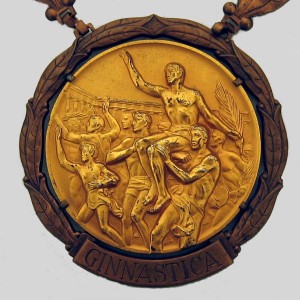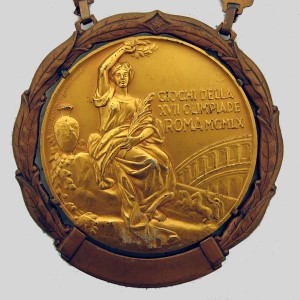Winner Medals


| 1st Place: | Gold Medal | Material: | Gilt Silver |
|---|---|---|---|
| Weight | 102 gr | ||
| 2nd Place: | Silver Medal | Material: | Silver |
| Weight | 102 gr | ||
| 3rd Place: | Bronze Medal | Material: | Bronze |
| Weight | 102 gr | ||
| Diameter: | 54 mm, in laurel wreath 68 mm |
Design by: | Prof. Guiseppe Cassioli, Florence, Italy * 22.10.1865 + 05.10.1942 |
| Mint: | Artistice Fiorentini | ||
| Thickness: | 3,5 mm | Ribbon: | Metal Chain |
| Obverse: | Victory seated over stadium. | ||
| Reverse: | Winner carried by jubilant athletes | ||
| Numbers of Medals: | Gold: 273 Silver: 270 Bronze: 277 | ||
The medal for winners; a bronze chain formed of olive leaf links, with a medal of honour in silver-gilt, in silver and in bronze. The base of the setting was inscribed with the particular sport. Medals awarded to winners of team events on the basis of " artificial classification" were not provided with chains. This chain however was not attached to the medals presented to the winners of "artificial" team events. |

From the left: A. Silaev, silver medal; J. Parti, gold medal and L. Rotman, bronze medal.
|
 Image Copyright © by www.rrauction.com |
The Medals for Winners 1960 The medal of honour awarded to winners, in accordance with the decisions of the I.O.C., remained that adopted many years previously at the Amsterdam Olympic Games (1928) despite the fact that its subject was not considered with any favour by Italian art critics. However, the original medal produced by Prof. Cassioli of Florence was adopted in the successive Olympic Games of Los Angeles (1932), Berlin (1936), London (1948), Helsinki (1952) and Melbourne (1956), preserving the same design and thus creating a tradition which prompted the I.O.C., on the occasion of the work of the 54th Session held at Tokyo, to decide that this same theme for the medals for winners should be continued for the 1960 Games. On the face of the medal there therefore appeared the same allegory conceived by Prof. Cassioli, while the back bore the words " Games of the XVII Olympiad - Rome 1960 ". The medal was encircled by a bronze band composed of laurel leaves. The commemorative medal of the Games was the work of Prof. Emilio Greco, who designed it according to his own personal ideas, avoiding any form of complicated symbolism and turning directly to the expressive clarity of a purely figurative style. On the face of the medal, the sculptor modelled a female nude running and bearing the Olympic torch with the Olympic rings in the background. On the back of the medal the artist depicted a flight of eagles rising from the Olympic Stadium of Rome and disappearing in the sky. This original conception at the same time symbolises the victories in the Olympic Games and their echo throughout the world. The Arts Committee, having obtained the approval of the Organising Committee, also entrusted Prof. Emilio Greco with the creation of a giant statue symbolising " The Olympic Torch ". This work by the sculptor Greco, inspired by modern figurative art, was placed close to the Palazzo dello Sport, at the highest point overlooking the waterfall and the small lake. The original model, presented by the sculptor to the Exhibition of Sport in History and Art, was set up in the centre of the main staircase in the Palazzo delle Scienze at E.U.R. In addition, under the auspices of the Italian Numismatic Society, a special gold medal for numismatic purposes only was coined and officially circulated, with the full agreement of the Organizing Committee of the Games. The medal, the work of the sculptor Renato Signorini, was coined in six different sizes. The rim of the largest sized medal bore the following inscription:- MMDCCXXXVI AB IN. OLYMPIIS MMDCCXIII AB U.C. MCMLX A CH.N. The Arts Committee, in agreement with the
Superintendency of Monuments in Lazio and with the Rome Municipality, decided
on holding sports venues in the Caracalla Baths for gymnastics and in the
Basilica of Maxentius for wrestling. (Source document: Official Report 1960, Vol. I, page 306) |